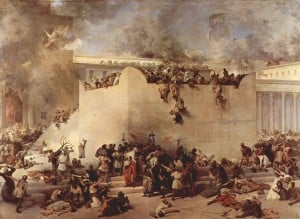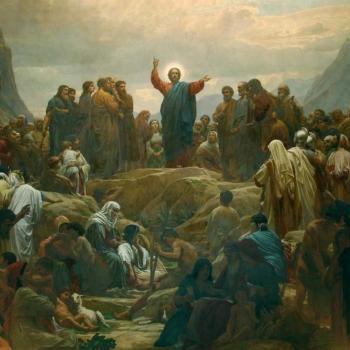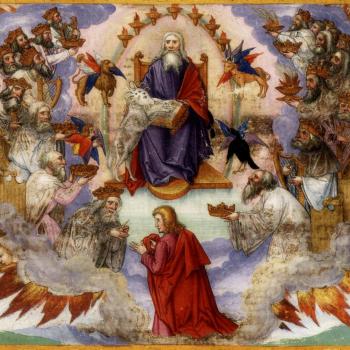 On a recent episode of Word Matters, Trevin Wax and I discussed Jesus’s warning of a future “abomination of desolation.” This passage gets some of the end-times chart junkies’ wheels spinning. And it’s actually a passage that someone brought up to me when I was teaching at my local church recently, so I thought it’d be worth addressing on the podcast, because I know others have wondered about it.
On a recent episode of Word Matters, Trevin Wax and I discussed Jesus’s warning of a future “abomination of desolation.” This passage gets some of the end-times chart junkies’ wheels spinning. And it’s actually a passage that someone brought up to me when I was teaching at my local church recently, so I thought it’d be worth addressing on the podcast, because I know others have wondered about it.
So here’s the passage:
“So when you see the abomination of desolation, spoken of by the prophet Daniel, standing in the holy place” (let the reader understand), “then those in Judea must flee to the mountains. A man on the housetop must not come down to get things out of his house, and a man in the field must not go back to get his coat. Woe to pregnant women and nursing mothers in those days! Pray that your escape may not be in winter or on a Sabbath. For at that time there will be great distress, the kind that hasn’t taken place from the beginning of the world until now and never will again. Unless those days were cut short, no one would be saved. But those days will be cut short because of the elect.”
(Matt. 24:15-22 CSB)
As always, we discussed a few prominent views on the passage, and then explained our own positions on it. Here are the three views, followed by my thoughts:
View #1: The abomination of desolation was the destruction of the Second Jewish Temple in 168 BC.
This view, held by most rabbis in Jesus’s day and by many still today, says that the Daniel 9 prophecy mentioned by Jesus here was fulfilled during the Jewish Maccabean Revolt (when Jews were fighting for religious liberty against the Greek empire), when the Greek king destroyed the Jewish Temple and setup an idol of Zeus.
Given that Jewish leaders largely hold this view, they don’t really care about Jesus’s interpretation of this. They think the prophecy is done, and that’s the end of the story.
View #2: The abomination of desolation was the Roman destruction of the Jewish Temple in AD 70.
This view would agree with the first—that seems pretty clear in Daniel’s vision that the abomination of desolation is the destruction of the Jewish Temple—but argue that Jesus’s reference to the prophecy happens in AD 70, when the Romans destroyed the temple. They might disagree on whether it’s a second fulfillment after the temple destruction in 168 BC.
The argument here is that Jesus seems to indicate that his original hearers will see this event themselves, and that they will need to be prepared to flee when it happens. So they might agree that Daniel’s prophecy already happened, and he’s preparing them for something similar, and Daniel’s prophecy lets them know what that is.
Interestingly enough, something like this actually happened within a decade of Jesus’ death. In AD 40, the Roman emperor, Caligula, tried to put a statue of himself in the temple. He was killed before he could do it, but he was intending to. It was AD 70, however, when Jerusalem fell, and Roman legions surrounded the temple and put whatever they wanted there.
History does record that when the temple fell in AD 70, Jews and Christians did literally “run for the hills” out of Rome and were scattered during this siege. Luke 21’s account of this gives that command.
View #3: The abomination of desolation is enacted by a future Antichrist during or around the Great Tribulation.
All views generally agree that the abomination of desolation has to do with the destruction of the Jewish temple, and they largely agree that some sort of “lawless man” will destroy the temple to prevent proper worship of God.
This view, popular in futurist and Dispensational circles, states that this hasn’t happened yet. Referring to prophecies in Ezekiel and elsewhere, proponents of this view say that a third temple will be built and Jews will begin to perform proper temple sacrifices during a 7-year peace treaty in the Middle East. The temple will then be destroyed by the Antichrist and he will build an idol of himself in its place, demanding worldwide worship. They use Revelation 13:14, which they believe discusses the Antichrist forcing Christians to worship an idol, as a key to understanding this passage.
My View
All three views have serious merits. It’s an historical fact that the Second Temple was destroyed in 168 BC, and that Jewish rabbis interpreted this as a fulfillment of Daniel 9. It’s also an historical fact that some Jews and Christians interpreted the fall of the temple in AD 70 as a fulfillment of Jesus’s words here. And, frankly, I’m always prone to assume that when Jesus says “you will see this” or “let the reader understand”—as he does here—it’s at least partially aimed at the audience he was first speaking to. So in that sense, I think Views #1 and #2 are in play.
View 3 also has some merit. You might argue that John in Revelation is originally speaking of Nero or Domitian doing the same sort of thing in his day. If Revelation is written around AD 65—which I doubt, but some argue—it could be that John foresees the fall of the of temple n AD 70 and is saying, “Jesus’s warnings are about to come true.” Or, it could be a future prophecy in the same vein of temple destructions that happened before. However, to be honest, I tend away from end-times logic on passages in which Jesus seems to indicate that something will happen before he dies or before his audience dies.
All that to say, I lean toward View #2. In this passage, Jesus uses Daniel’s prophecy as a familiar illustration to point to something they need to look out for (this is why he tells his original headers, “let the reader understand”). Historically, it’s difficult to deny these prophecies being fulfilled more than once—or at least the general principle that the Jewish temple would be destroyed by an anti-Christian emperor and replaced by an idol. This happens a few times. So Jesus seems to make the “abomination of desolation” language of Daniel 9 a dual fulfillment or some sort of type of prophecy (this one is like that one).
But I can’t fully dismiss View #3, even though it would have to be true alongside View #2. At the end of this prophecy, Jesus says that after this happens, he will return on the clouds and gather his elect. This phrase sounds way too much like a prophecy about his Second Coming for me to deny the future aspect of this. I don’t want to deny that—he didn’t return immediately after the temple fell in AD 70, so maybe there’s something more going on here.
So, here’s my best attempt at reconciling all of this: Jesus warned of the temple falling in AD 70, and indicated that he’d return some time after that. This is why he says, “Be ready for the temple to fall and to run for the hills, but not even I know when I will return.” He’s seems sure that the temple is going to destroyed and that his audience will see it for themselves, but is unsure when he will return after that—but he isn’t going to return before it happens. This is why View #2 holds the most weight for me, but I could see View #3 being true, assuming another type of this prophecy happens around Jesus’s second coming.
Check out some other confusing passages we’ve tackled:
- Was Jesus created?
- What does the number 666 mean?
- Was Adam an historical person?
- Did Jesus call a woman a dog?
—
Stay in touch! Email me at ChurchGrammar@gmail.com or connect with me on Academia.edu.
















